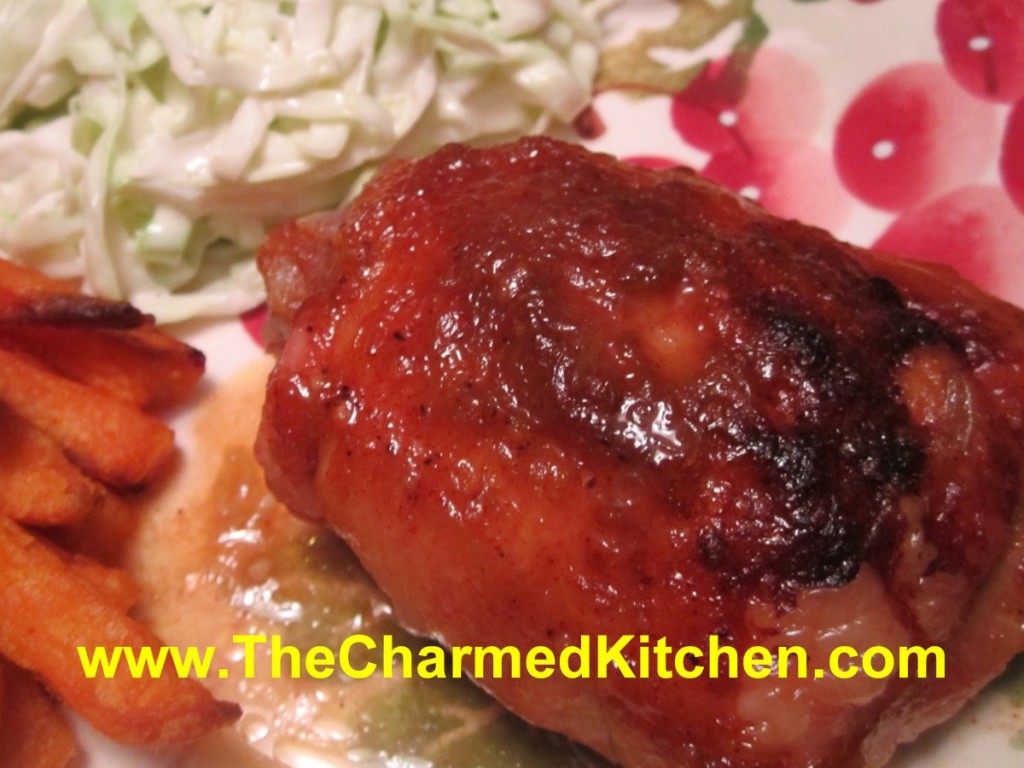Breakfast Memories with Dad
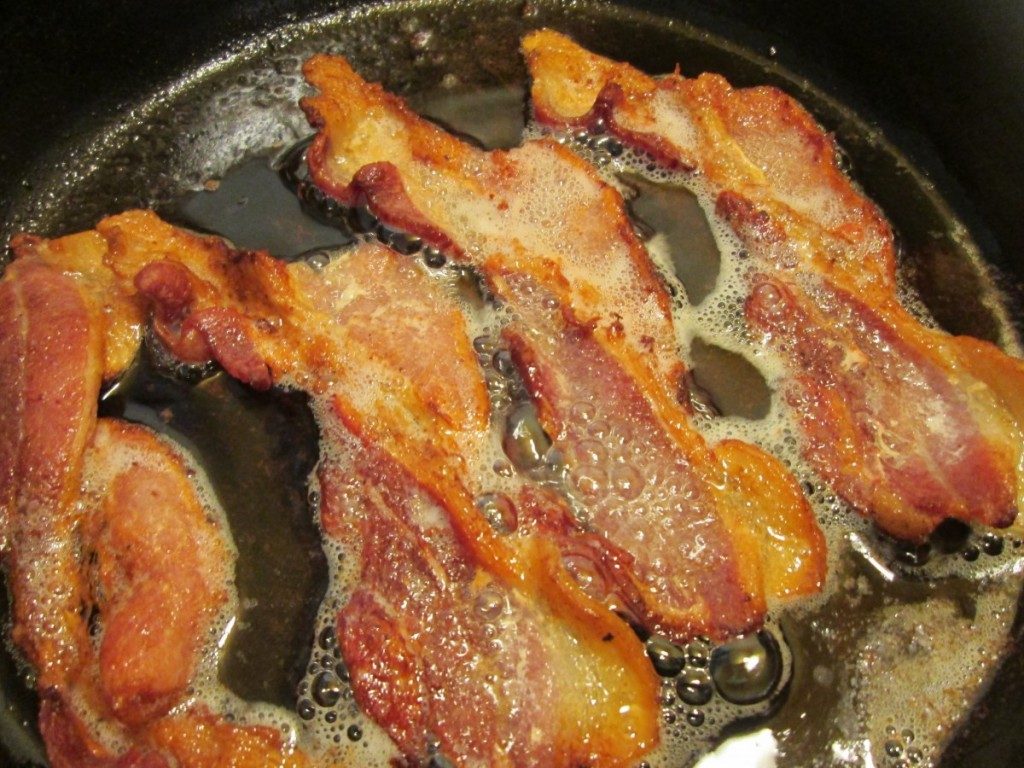
One of my favorite memories of my Dad, involved a very special breakfast. It was a breakfast only he and I shared.
Every summer, there was a park we would go to for family picnics. It was called Pine Way Trails. It has long ago been sold and the land developed.
The place would get very crowded, so we had to go early to get a prime location by the lake, and enough picnic tables for everyone. My Dad and I would go before anyone else.
Back then, it made me feel so special to go and to help. I am guessing it was because I was the baby, and no one else wanted to get up so early.
Dad and I would get there just as Pine Way Trails opened. The mist would still be rising off the lake. I’d help him unpack the car and place stuff on the tables we were claiming for the day. We would move them together and make sure they were level. Dad didn’t want wobbly tables.
Then, he’d get a fire started in one of the grills. He always brought his cast iron skillet. Over the fire, he’d cook us bacon and then cook a couple of eggs. Dad had his thermos of coffee, and I had orange juice.
On paper plates we’d sit and enjoy our breakfast together. I don’t think, as a kid, I really appreciated the skill it took to get that fire just right. The bacon was crisp, but never burnt and the eggs would be sunny side up- with the yolks warm, yet runny. I’d use my bacon to get the last of the yolk off my plate.
Later in the day, everyone else would arrive. My mom, sister and brother, aunts, uncles, cousins, friends. We’d have a wonderful day together swimming and fishing and eating grilled hot dogs and hamburgers, chicken and salads and fresh melon. It was noisy and so much fun.
That special part of the day for me, was the breakfast my Father and I shared, quietly by the lake.
I got out the cast iron skillet this morning- cooked some bacon and eggs and thought of him.
Homemade Chinotto Syrup

I will admit that I didn’t know what chinotto was until a friend sent me the recipe. Thanks, Joe. Now I love it and I usually have a jar of it in the fridge. Inspired by a citrus fruit of the same name, it is a syrup made from assorted citrus fruits and spices that are roasted, sweetened, and later strained out. The chinotto is then used to flavor and sweeten other beverages. It is often just added to soda water, but it can be used in all sorts of cocktails, too. The flavor is complex and fun to play around with in different drinks.
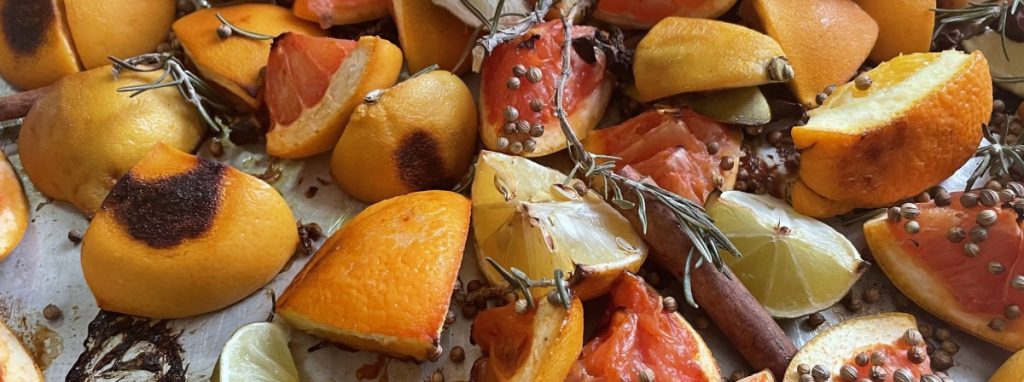
So here is how I make it- based on several recipes I found on-line, several batches and the final way that I make it now.
Chinotto
A good range of citrus – I used three or 4 grapefruit, oranges, lemons and limes
4-5 sprigs of fresh rosemary
1 T. black pepper corns
3-4 whole cloves
3-4 T. Coriander seeds
2-3 Cinnamon sticks
5-6 star anise
Sugar syrup- recipe follows
Cut the citrus up in equal size and lay on a large baking tray and sprinkle them equally with the herbs and spices. Pop into a 300 degree oven and roast slowly until blackened. The blackening of the citrus causes the flavors to really pop. Once blackened, take out of the oven and cool down. When cool enough to handle, spoon into a large jar that has a lid. Pour in enough sugar syrup to completely cover the fruit and spices. You should have about an equal amount- if it’s a quart of fruit and spices, then a quart of sugar syrup. Once you have filled the jar and the fruit is covered, put on the lid and refrigerate for up to a month. The longer you refrigerate the “spicier” it becomes. Strain out the solids and return to the fridge. Add a good drizzle to soda and a slice of citrus fruit and drink!
Simple sugar syrup
Combine equal parts of sugar and water and stir until sugar dissolves. For a recipe of chinotto, I used about 3 cups of water and sugar. You can always make a little more if it isn’t enough to cover the fruit.
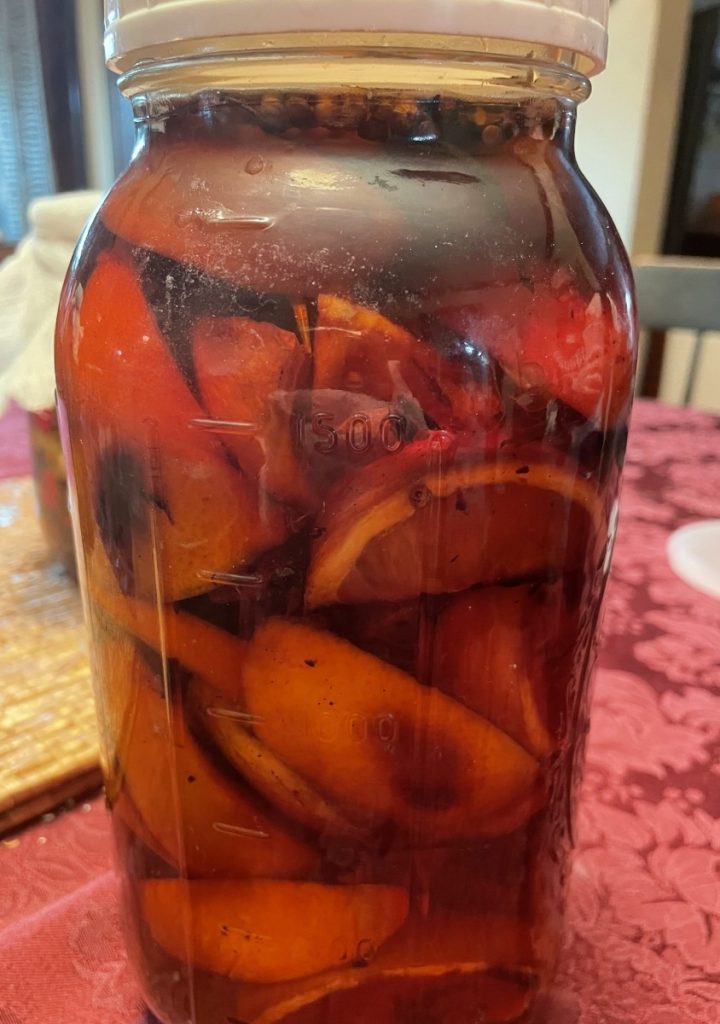
Frozen Chocolate Malted Cheesecake
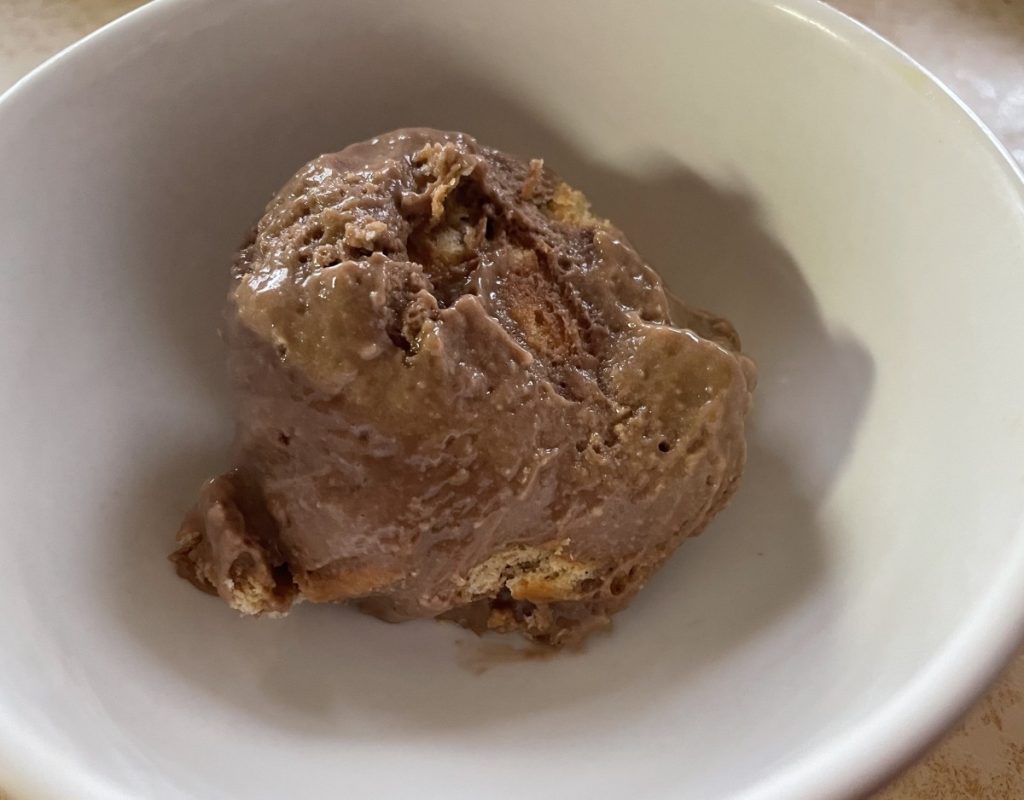
Here is yet another variation on that frozen dessert recipe I have been playing around with. This is the recipe with cottage cheese as the base and any number of add-ins for different versions. I have already made a cherry- strawberry “cheesecake” and a lemon curd one, too.
This chocolate one came out very nice. I might experiment with adding other flavors later or maybe freezing it in Popsicle molds.
Another idea is to pour the mixture in a graham cracker pie crust, rather than crumbling the crackers in the dessert. I could see that working nicely. Maybe even put graham cracker crust in muffin tins…..
They are so simple to make and require just a food processor to blend the ingredients together. No ice cream machine is needed. I called them cheesecakes because that is what they reminded me of.
You can “fatten” them up a little by adding 1/2 cup of whipping cream, but they are nice and creamy without. I also used sugar to sweeten so far, but you could use any sweetener you prefer. So here is the recipe for my latest version of what might be my favorite frozen dessert this summer.
Frozen Chocolate Malted Cheesecake
1 (28 oz.) carton of cottage cheese
¾ c. chocolate syrup
¾ c. malted milk powder
Sugar to taste, I used about ½ cup
1 T. vanilla extract
5-9 graham crackers, crumbled depending on your preference
Combine first 5 ingredients in a food processor or blender until very smooth. Taste to see if you want to add more sugar. Pour into a 2 quart bowl and stir in the crushed crackers. Place mixture in a freezer safe container that has a lid. Affix the lid and freeze. Makes 5-6 cups.
Note: I could see a lot of possible variations for this recipe. I used cinnamon graham crackers, but it might be fun to use chocolate graham crackers or crushed up chocolate sandwich cookies. You could add some instant coffee powder or mint extract. Perhaps some chopped chocolate. Have some fun with this recipe.
Strawberry Ice Cream Cake Roll
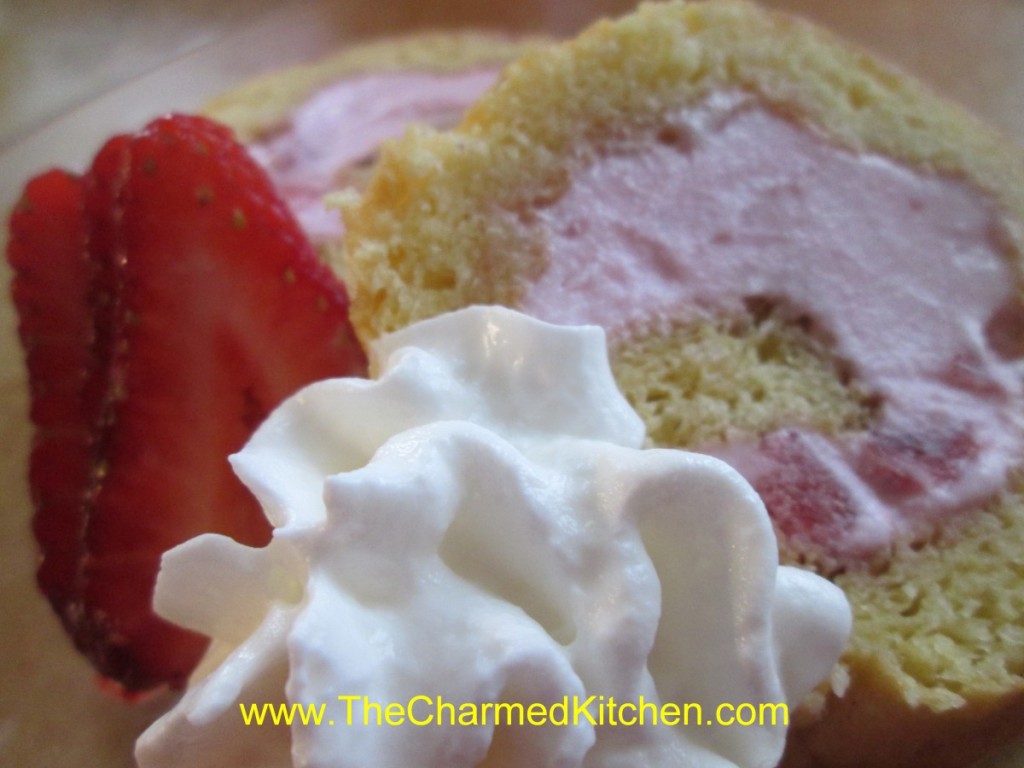
This is the perfect summer dessert. Fresh berries, a light, citrus-scented cake and ice cream. What more could you want?
When you say cake roll, I think a lot of people first think of a pumpkin roll or perhaps a Buche de Noel (yule log). There are so many more desserts you can make with them. Cake rolls can be made in many flavors and they can be filled with custard, frosting, fruit, ice cream and more.
For this sponge cake roll, I used homemade strawberry ice cream to fill it, recipe follows. You could use store bought ice cream, if you prefer.
Start with the sponge cake roll recipe below, and use whatever flavor ice cream you like. You’ll need about a quart of ice cream- or a little more.
Once finished, you just wrap it up and pop the cake in the freezer until needed. Great to have on hand for summer parties and cook outs. Perhaps a nice dessert for Father’s Day? You can decorate with fresh berries when serving. Blueberries would make this a fun red, white and blue dessert for Memorial Day or the 4th of July.
Sponge Cake Roll
This sponge cake roll can be filled with whipped cream or ice cream, or use your favorite filling.
5 eggs, separated
2/3 cup granulated sugar
1 teaspoon lemon juice
1/2 teaspoon finely grated lemon zest
2/3 cup cake flour*
1/4 teaspoon salt
1 teaspoon baking soda
3 tablespoons melted butter
Beat egg yolks until thicken and lemon colored; gradually add 1/3 cup of the granulated sugar, the lemon juice and the lemon zest. Beat egg whites until almost stiff then gradually beat in the remaining 1/3 cup sugar. Beat until stiff peaks form. Fold yolk mixture into whites. Sift dry ingredients into a separate container; add to egg mixture, folding in carefully. Fold in melted butter. Pour batter into waxed paper-lined 10x15x1-inch jelly roll pan. Bake at 375° for 12 minutes. Sprinkle with confectioners’ sugar. Turn onto a clean kitchen towel which has been generously dusted with confectioners’ sugar. Trim edges, if necessary; roll cake up, towel and all, while still warm. Let cool completely. Unroll and fill with whipped cream or ice cream then re-roll cake. The trick is to let the ice cream soften up a few minutes before spreading it on the cake. But don’t wait too long. Rather than trying to let the ice cream get soft enough to spread I used a spatula to sort of cut slices of ice cream and place them on the cake. Store ice cream cake roll in freezer until ready to slice and serve.
*If you don’t have cake flour you can make your own. Measure out a cup of all purpose flour, remove 2 tablespoons of flour and replace them with 2 tablespoons of cornstarch. For larger amounts place 7 cups of flour in a bowl and combine with 1 cup of cornstarch. Mix well or even sift together. Store in an airtight container.
Strawberry Ice Cream
2 c. chopped strawberries
1 c. sugar
1 T. vanilla
2 c. cream or half and half or a combination. You can also use some milk or even almond or rice milk.
Additional sugar to taste
Place strawberries, vanilla and sugar in saucepan and bring to a simmer, stirring occasionally. Remove from heat and chill. Combine chilled berry mixture with cream. Add additional sugar if you like. Remember that once it is frozen the ice cream will not taste as sweet so make this mixture a little sweeter than you want the final product to be. How much sugar you add varies with personal taste, and how sweet the berries are. Place in an ice cream maker and process according to manufacturer’s directions. Once finished put in an air- tight container and place in freezer. Makes about 1 quart.

Frozen Lemon Cheesecake
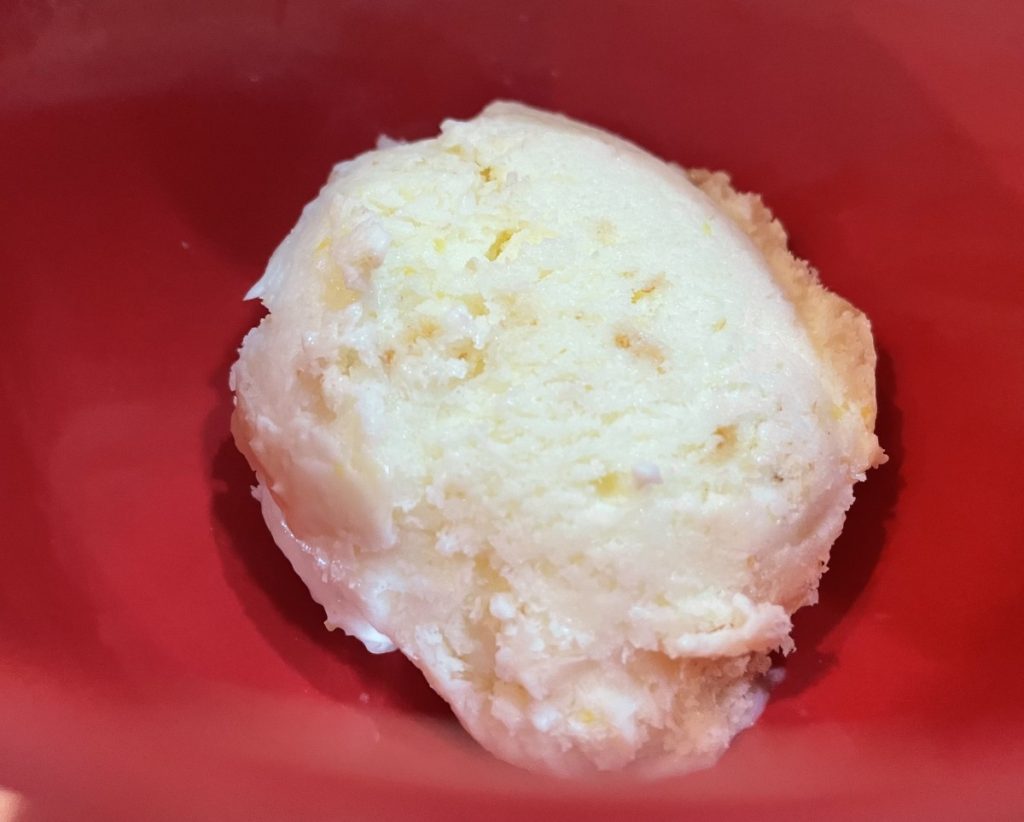
This is a great summertime dessert. It is refreshing and very easy to make. No special equipment, other than a blender or food processor. No ice cream maker required. The result is sweet and creamy with just enough lemony tang.
Not too long ago I posted a recipe using cottage cheese to make a frozen dessert. I couldn’t call it ice cream, so I called it a frozen cheesecake. It kind of reminded me of cheesecake. The first was made with cherries and strawberries, but I wanted to try new variations. I have also made it with blackberry jam and another version with chocolate syrup and malted milk powder. Those recipes will be posted soon.
This is my lemon cheesecake version. It is a combination of cottage cheese and lemon curd, with a few other ingredients. Crumbled graham crackers are stirred in before freezing. It may be my favorite variation so far. I used homemade lemon curd, but you could use a jar of store bought. The recipe for the lemon curd is below the cheesecake recipe.
So here is the recipe.
Frozen Lemon Cheesecake
1 (28 oz.) carton of cottage cheese
Sugar to taste, I used about ½ cup
1 recipe lemon curd- recipe follows, or 2 cups store bought lemon curd
2-4 T. lemon juice
1 T. vanilla extract
6-9 graham crackers, crumbled
Combine first 5 ingredients in a food processor or blender until very smooth. Taste to see if you want to add more sugar or lemon juice. Pour into a 2 quart bowl and stir in the crushed crackers. Place mixture in a freezer safe container that has a lid. Affix the lid and freeze. Makes 5-6 cups.
Lemon Curd
1/2 c. lemon juice
zest from one good sized lemon- you should have 2-3 teaspoons
1/2 c. sugar
3 eggs
6 T. unsalted butter- cut into little cubes
In medium saucepan, combine all ingredients. Whisk the mixture until the eggs are well blended. Cook over medium low heat, whisking often, until the mixture thickens. This will take 5-7 minutes. Whisk more often as mixtures warms and starts to thicken. Better to heat over lower heat and take longer than cook over too high a heat. You don’t want the eggs to scramble. Once the mixture is thickened , transfer to a bowl or jar. Cover the surface with a piece of plastic wrap to keep the surface from developing a skin- like any pudding will do. Chill until ready to use. Makes about 2 cups. Will keep in fridge a week or two.
Garlic Scapes Hummus
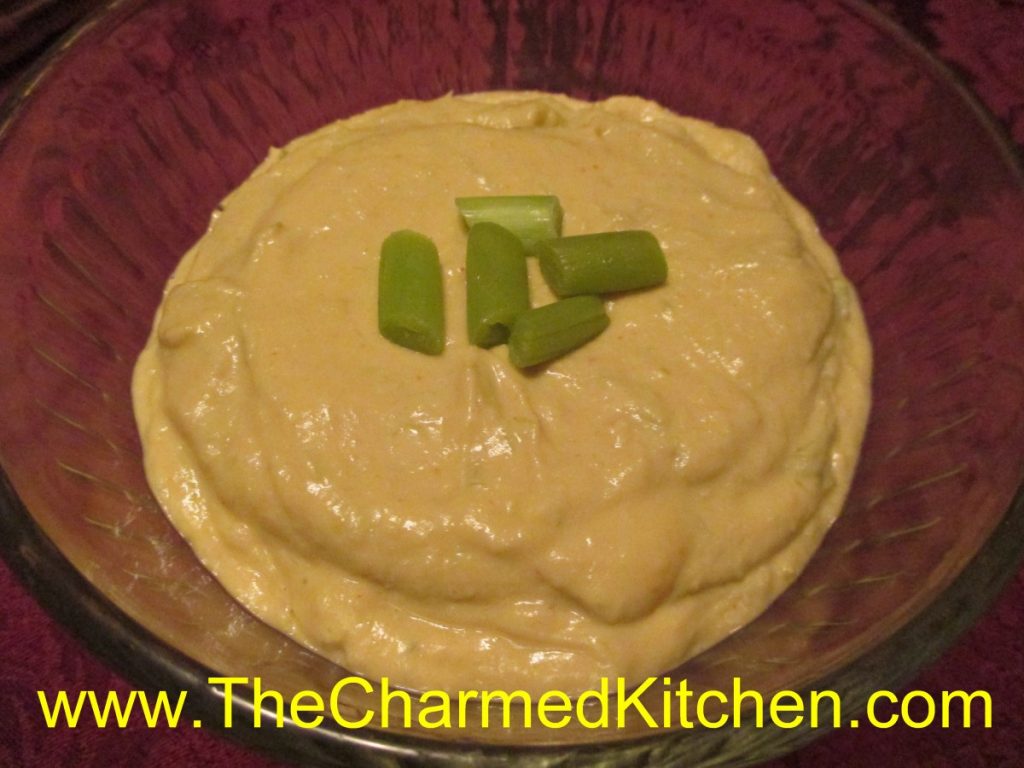
Around here, garlic scapes are in season. I am lucky to have a dear friend who shared some with me- thanks Courtney!! I find myself cooking with them in everything I can. Everyone seems to be talking about scapes and looking for new ways to use them. There is even a word for it – scorpacciata.
Scorpacciata is an Italian word that means consuming large amounts of a particular local ingredient while it’s in season.
Scapes, if you didn’t know, are the tops of hard-neck variety garlic. They are cut off this time to year- to help the plants produce larger heads. They curl as they grow. You should be able to find them at your local farm market. They can be eaten raw or cooked. They can be a little woody when raw.
This time, I steamed the scapes, and added them to my hummus. The end result was really good. The scapes replaced the garlic cloves, adding their own personality to the dish. I switched the dish up a little more, by using avocado oil, instead of the traditional olive oil.
So here is one more recipe to use those lovely, seasonal garlic scapes.
Garlic Scapes Hummus
1 can garbanzo beans, drained- I used 2 cups of cooked garbanzos I had made from dried
½ c. chopped garlic scapes- 1 or 2 garlic scapes- steamed 5 minutes and chopped
¼ c. olive oil or avocado oil
2 T. lemon juice – about 1 lemon
2 T. tahini (sesame seed paste)
salt and hot pepper sauce to taste
Combine all ingredients in a blender or food processor until smooth. Adjust seasonings. Chill. Serve with pita bread, crackers or fresh vegetables. Also nice spread in a pita bread with sliced tomatoes, cucumbers and lettuce. Freezes well.
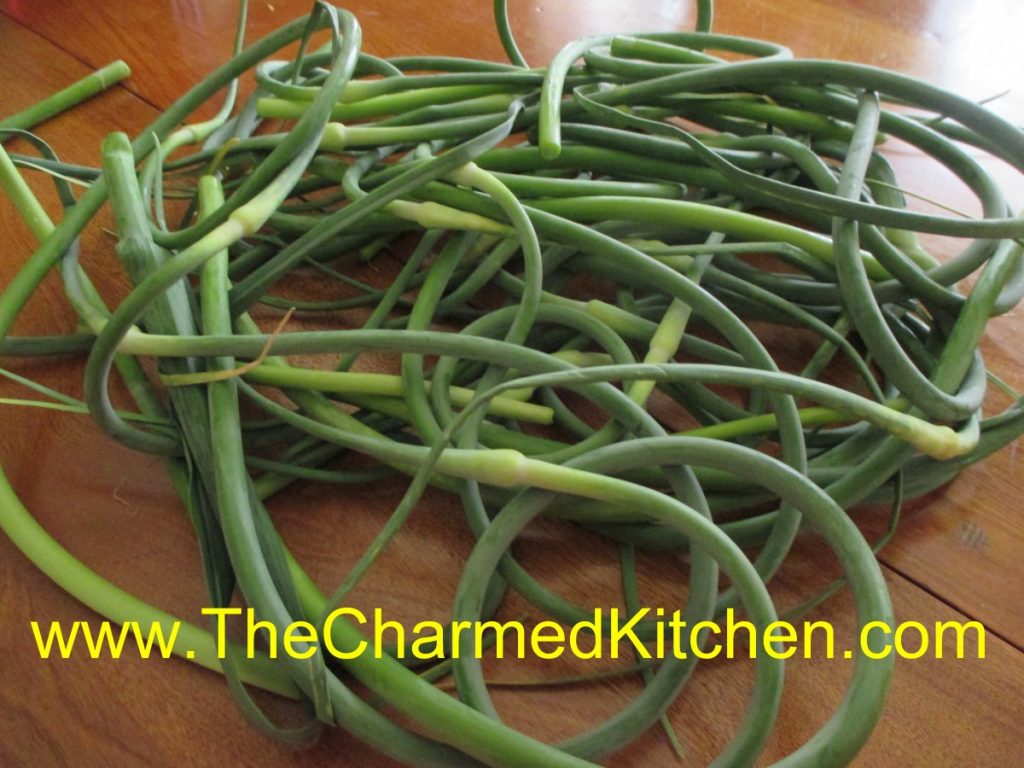
Cooking with Garlic Scapes

If you have never had garlic scapes, you don’t know what you are missing. Garlic scapes are the green shoots removed from hard-neck varieties of garlic. By removing the shoots, the bulbs will get bigger. So farmers and gardeners remove them. Garlic scapes curl as they grow, so they are easy to identify if you see some at your local farm market. They are showing up at farm markets around here right now.
Mine were a gift from a friend. Thanks, Courtney, for my scapes. Joe says thanks, too.
Garlic scapes are good served raw, or barely cooked. When cooked, the flavor mellows a lot. I love to steam garlic scapes for about 5 minutes, then just eat like fresh green beans, with butter and salt. I steamed a bunch of scapes- then chopped them up and added to potato salad. So tasty!! They can also be grilled! The slight charring gives them a wonderful smokey flavor.
They have a rich, garlic flavor that is all the sweeter because of the short time they are around. Enjoy them when you can- they will be gone soon. I sometimes use scapes in place of basil, in my pesto recipe, or combine them with parsley in a garlic scapes-parsley pesto. You can also combine the garlic scapes with cottage cheese in the blender- add a little lemon juice and hot sauce for a tasty dip. Here are some more recipes for cooking with garlic scapes.
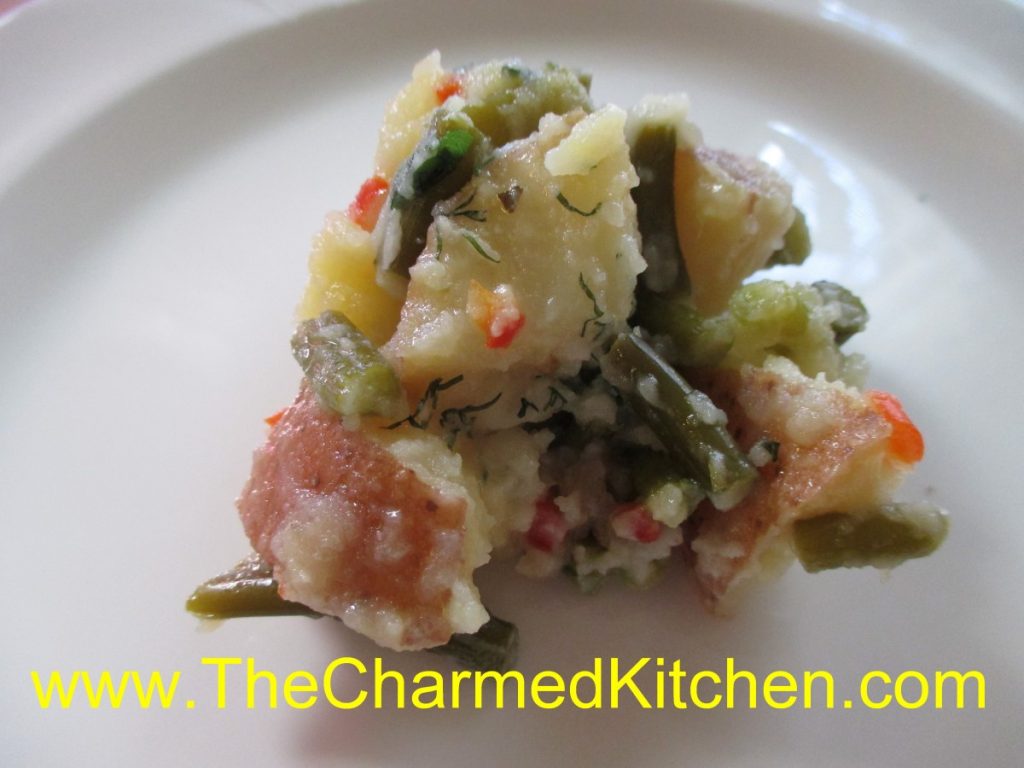
Garlic Scapes Potato Salad
4-5 garlic scapes
2 lbs. red skinned potatoes*
½ cup minced sweet pepper
½ c. olive oil
½ c. apple cider vinegar
2 T. sugar
2 T. chopped parsley
2 t. fresh dill weed
Salt and pepper to taste
Hot sauce to taste
Steam the scapes for 5 minutes. Cool a little, and cut into ¾ -inch slices. You should end up with about 1½ of sliced scapes when done. Place in a medium bowl. Cook potatoes until tender. I baked mine in a microwave until tender and then cut into cubes. Baking them is also a nice way to cook the potatoes. You can also opt to cut into cubes first and boil the potatoes. Whatever method to cook the potatoes is fine with me. Take the potatoes, while still warm, and place in the bowl with the scapes. Mix the rest of the ingredients together in a small bowl and stir until sugar dissolves. Pour over warm potato mix, tossing to coat evenly. Adjust seasonings. Chill and serve. Serves 6-8.
* You can really use any potato you like.
Garlic Scapes Pesto Sauce
1 c. chopped scapes – you can also use half scapes, half parsley
1/4 c. olive oil
3-4 cloves garlic
Salt to taste
1/2 c. pine nuts, sunflower seeds, pecans or walnuts
1 c. fresh grated Parmesan cheese
Combine all ingredients, except the cheese, in a blender and mix until smooth. Stir in the cheese and toss over hot, cooked pasta or use as a sauce on meat and poultry. Sauce will keep a few days in the fridge and makes about 1 1/2 cups, enough for 1 lb. of cooked pasta.
Lebanese Garlic Sauce
1/2 c. chopped garlic scapes
1 cup lemon juice
1 teaspoon salt
2 cups olive oil
In the container of a blender, combine the garlic scapes, lemon juice and salt. Blend at medium speed until smooth. Continue blending while pouring olive oil into the blender in a thin stream. The mixture should become thick and white almost like mayo. Store refrigerated in a glass container. Nice on hot pasta, cooked rice or grains or brushed on meats while cooking. It also is a great salad dressing.
Garlic Scapes with Broccoli
1 c. chopped garlic scapes
1 1/2 teaspoons salt
1 bunch broccoli, cut into florets, steamed 5 minutes, cooled
1/3 cup olive oil
1/4 cup red wine vinegar
1 tablespoon Dijon mustard
1/2 cup grated Parmesan cheese, or to taste
Place garlic scapes in a food processor with the salt and blend into a paste. Add olive oil, vinegar, and mustard. Pulse until smooth. Place garlic scapes mixture in a bowl and add the broccoli. Stir to coat. Chill for 3 hours to marinate, stirring occasionally. Sprinkle with Parmesan cheese before serving. Tastes even better the next day!!!
Candied Bacon
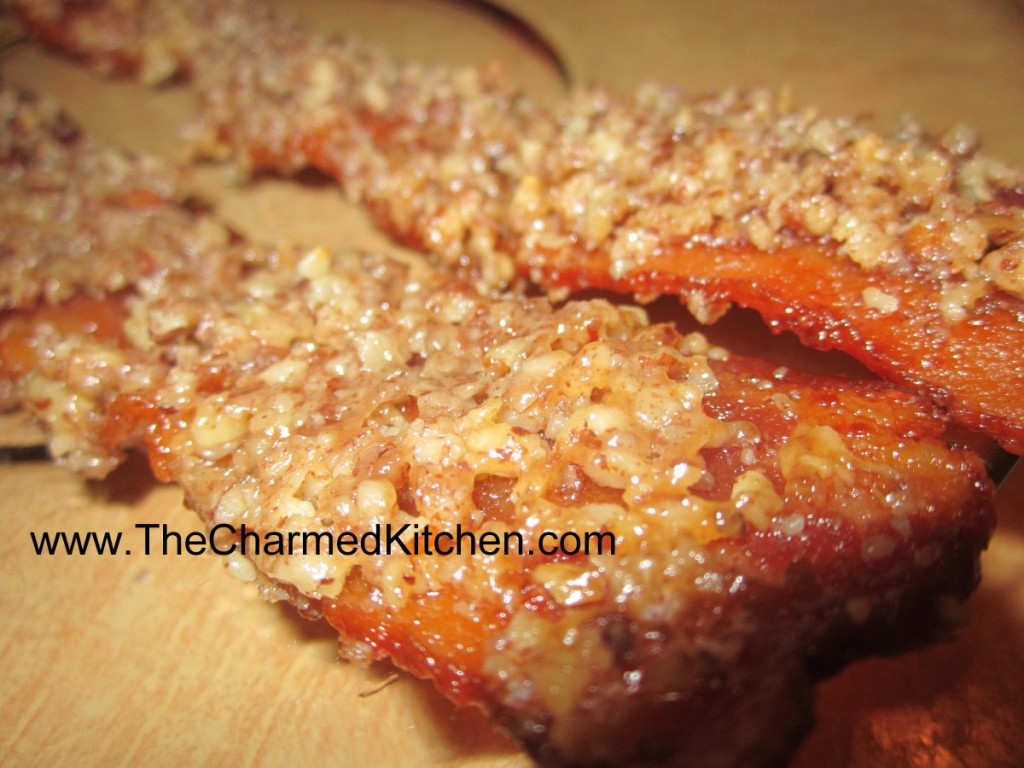
This candied bacon only has three ingredients- bacon, maple syrup and chopped nuts. The combination in sublime. Salty, sweet, smoky all in one crunchy bite. Friends and family love it!! Nice for dad on Father’s Day.
The bacon is baked, then coated with maple syrup and chopped nuts. It is returned to the oven, where it bakes until the bacon is crisp and the coating it toasted, almost caramelized. It gets crisper once it cools down.
You can make a spicier version by sprinkling with a little cayenne pepper or adding hot sauce to the maple syrup.
Candied Bacon
1 lb. bacon
3/4 c. – 1 c. maple syrup
3/4 c. – 1 c. crushed pecans (or any nuts you like! I like to leave some
larger pieces and then mix in some more finely ground)
Preheat oven to 350. Put bacon in baking pan and bake about halfway through (about 5-7 minutes or so). Drain most of the grease and allow to cool slightly. Coat each piece in syrup, roll in nuts and put back on pan. You may need more nuts as you go along, though it’s up to you how much to cover them. Bake another 7-9 minutes, until desired crispness. If you do like crisper bacon, just be sure to move the cooked bacon quickly off the baking sheet onto parchment paper, since the syrup will harden. Allow longer cooking times with thicker bacon.
Homemade Strawberry Liqueur

This strawberry liqueur is like summer in a bottle. I make a lot of different liqueurs and strawberry is one of my absolute favorites. It is wonderful for sipping or over ice. It is also a fun addition to any number of cocktails. A friend adds it to ice cream with extra berries and blends it up for an adult strawberry milkshake.
With strawberries in season, this is the time of year to enjoy them. I want to preserve some for later, too. I made strawberry jam and dehydrated some. I will also freeze some.
Another way to preserve strawberries, is by making a liqueur with them. It is pretty simple. Just combine berries with vodka and a small amount of powdered sugar. I use half gallon canning jars for this, but you could use any food safe container with a tight fitting lid.
Let the mixture steep long enough for the berries to infuse the alcohol with their flavor. You can sweeten it later on, or even leave it unsweetened, if you prefer. I like to sip the liqueur as is, or serve on the rocks with a splash of club soda.
Strawberry Liqueur
3 cups fresh strawberries, sliced
3 T. powdered sugar
3 c. vodka
1 c. simple syrup*
Sprinkle powdered sugar over berries and let dissolve. Pour over vodka and let steep 2 weeks. Crush berries and strain then filter. Add sugar syrup and mature 1 week. Makes 5 cups.
*Simple syrup is made from 1 cup of sugar and ½ cup of water. Bring to a boil, then cool. You will have 1 cup of syrup. You can sweeten your liqueur with honey, if you prefer. Watch when you substitute honey for sugar, as it is sweeter and stronger flavored. Better to use orange or clover honey. Add to suit your taste.

